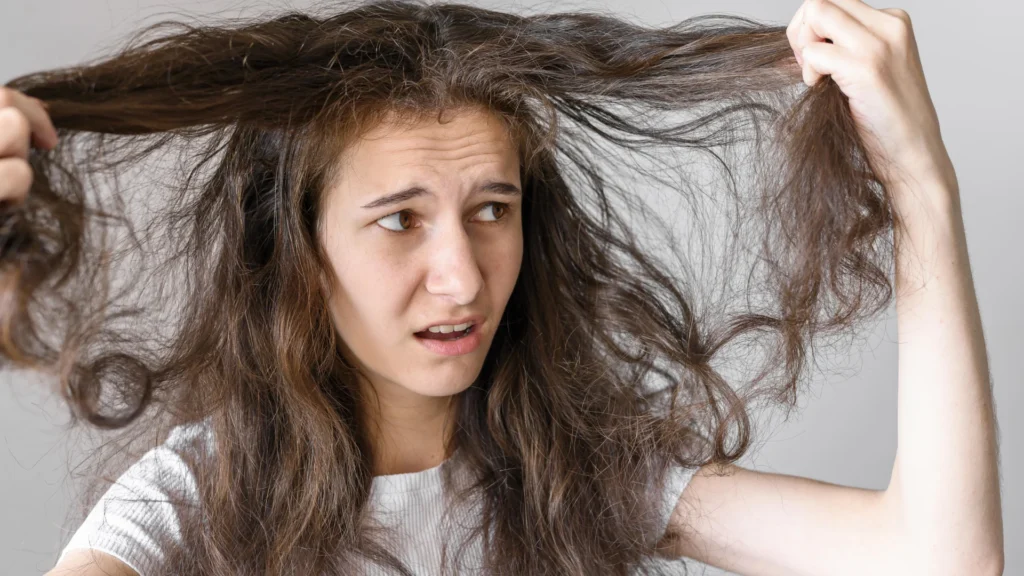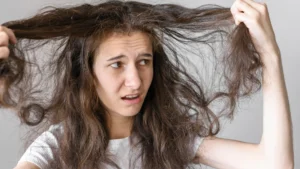Heat Damaged Hair like curling irons, straighteners, and blow dryers can surely give you gorgeous, styled hair.
But what’s the dark side? Heat damage!
Dry, brittle, and frizzy hair can become your worst nightmare.
If you’re reading this, it’s likely you’re looking for ways to breathe life back into your frizzy hair.
Do not be afraid! This guide will show you easy and effective ways to get your locks back.
What is Heat Damage?
Heat damage happens when your hair is regularly exposed to very high temperatures from tools like straighteners, curlers, and blow dryers. These high temperatures can break down the natural protective layer around each hair strand.
This leads to a loss of essential moisture that keeps your hair healthy. Without this moisture, your hair can become very dry and feel rough to the touch.
Over time, this lack of moisture weakens your hair, making it more prone to breakage and split ends. Your hair may start to look dull and lose its natural shine. It may also become frizzy and hard to manage.
Essentially, when you subject your hair to too much heat, it can lose its strength and elasticity, making it more susceptible to damage and less likely to look its best.
Understanding how heat affects your hair is the first step in knowing how to fix it.
Signs of Heat Damage
Wondering how to identify heat-damaged hair?
Here are some common signs:
- Dry and Brittle Texture: Your hair feels like straw and breaks easily.
- Split Ends: These are a direct result of repeated heating.
- Frizz: Heat-damaged hair often appears frizzy and has flyaways.
- Lack of Shine: Your hair looks dull and lacks natural shine.
- Tangles: Damaged hair tangles more easily than healthy hair.
Step-by-Step Solutions to Fix Heat Damaged Hair
It’s never fun to realize your hair has been damaged by heat, but don’t worry, there are ways to bring it back to life! Each step you take will go a long way in treating and revitalizing your hair.
Let’s get started with some easy and effective solutions.
Step 1: Trim the Damaged Ends
If you see any split ends or areas of your hair that are badly damaged, getting a trim is a great place to start. This won’t just make your hair look healthier right away, but it will also prevent further breakage and make your hair easier to manage.
Step 2: Cut Down on Heat Styling Tools
To give your hair a real chance to repair itself, you’ll need to reduce using heat styling tools. Let your hair breathe by giving it some downtime. Instead, try embracing your natural texture and experiment with heatless styling methods. This break from heat will significantly help in the healing process.
Step 3: Incorporate Deep Conditioning Treatments
Deep conditioning treatments can work wonders on heat-damaged hair. These treatments are packed with nutrients that replenish lost moisture and strengthen your hair.
Here are a few you can try:
- Coconut Oil: Apply it to your hair and leave it on overnight for the best results.
- Olive Oil: This oil is full of antioxidants and can help bring back softness and shine.
- Aloe Vera: Known for its moisturizing properties, it can soothe and repair damaged hair follicles.
Step 4: Use Protein Treatments to Restore Hair Structure
Because your hair is made of proteins, protein treatments can help rebuild and fortify its structure. Find hair masks or treatments that feature proteins like keratin, silk, or wheat protein.
DIY Protein Treatment:
- Mix one egg with two tablespoons of yogurt.
- Apply the mixture to your hair.
- Leave it on for 20-30 minutes before rinsing with cool water.
Step 5: Steer Clear of Harsh Chemicals
Avoid products that contain sulfates and parabens, as these can dry out your hair even more. Instead, choose gentle, natural shampoos and conditioners.
Step 6: Schedule Regular Trims for Maintenance
After your initial trim, it’s a good idea to maintain regular trims every 6-8 weeks to keep your hair healthy. Regular trimming will help prevent split ends and breakage.
Step 7: Weekly Hair Masks for Extra Care
Using a hair mask once a week can give your hair the extra hydration and nutrients it needs.
DIY Hair Mask:
- Mix half an avocado with one tablespoon of honey and one tablespoon of olive oil.
- Apply the mixture to your hair and leave it on for 30 minutes.
- Rinse thoroughly with cool water.
Step 8: Always Use Heat Protectants When Styling
If you can’t completely give up heat styling tools, make sure to always use a heat protectant spray. This helps to create a barrier around your hair, reducing the damage from high temperatures.
Step 9: Stay Hydrated and Eat Healthy for Better Hair
Finally, remember that what you put into your body affects your hair. Make sure you’re drinking plenty of water and eating a balanced diet rich in vitamins and minerals. Healthy hair starts from the inside out!
Can Heat-Damaged Hair Ever Fully Recover?
While heat-damaged hair can significantly improve with proper care, it’s important to remember that any damage already done to the hair shaft is permanent. The good news is that with consistent treatments, trims, and by avoiding further damage, you can make your hair look and feel much healthier.
Growth of new, healthy hair combined with proper maintenance will give the best overall results.
Are There Any Hairstyles I Can Use to Protect My Hair While It Heals?
Yes, protective hairstyles can help shield your hair from further damage while it heals. Styles such as braids, buns, and twists are excellent as they minimize hair manipulation and reduce the need for heat styling.
When choosing protective styles, make sure they are not too tight to avoid breakage from tension.
Takeaway
There you have it!
By incorporating these tips and treatments, you can gradually restore your hair’s health and combat heat damage. Remember, patience is key.
Your hair won’t repair overnight, but with consistent care and attention, you’ll see improvement.








2 thoughts on “How to Fix Heat Damaged Hair: A Repair Guide”